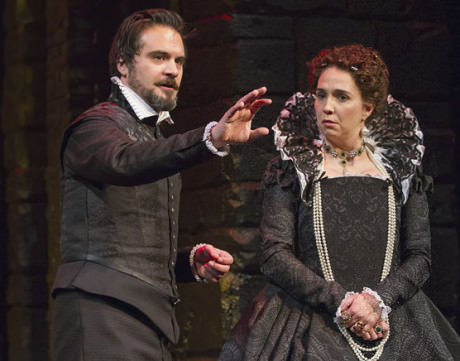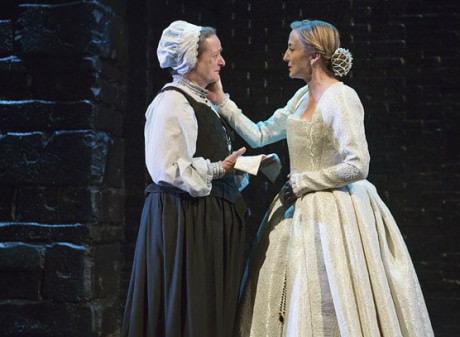Frederic Schiller’s historical drama, Mary Stuart (1800), gives us two potent, yet vulnerable women, Elizabeth I and Mary Queen of Scots. It gives us religious fanaticism — no, not Sunni versus Shia but protestant versus catholic, and the bloodletting is only just beginning. It gives us the political and the ethical, and the machinations in which the politicians (or the Queen) engage in order to appear scrupulous decision makers.

Mary Stuart, this new adaptation by Peter Oswald now playing at the Folger Theatre, gives us a searing glimpse into our own contemporary human dilemma through a 200-year-old lens about a 500-year-old tussle.
The results are as beautiful as they are engaging.
For our review by Sophia Howes, click here.
For me, Schiller’s dramas are as much about philosophy and the painful contradictions between our values and our expediencies as they are about life’s tragic possibilities. And Mary Stuart more than illuminates that point.
We dream of ourselves as representative of high morals, values, and ideals. We hold ethical principles up and rage against the Other and their despicable deeds, for it is “those people” who know not what “right” is. It is “those people” who commit “evil” while we march forward into an eternal sunshine.
Schiller might have yearned for such a person, some Enlightenment-producing individual who matches his life’s choices with his ideals; but he knew that in the real politick of day to day existence the only morally pure soul is the soul that has been spared the horrible choice of having to pick up a gun or a sword and blow or slice someone’s head off in self-defense or in acts of justice. The only morally pure person is she (or he) who has had others do the nasty deeds for her (or him).
In Mary Stuart, Henry VIII is dead. Elizabeth I, daughter of Anne Boleyn, the 2nd wife of Henry VIII who was executed for treasonous adultery and incest, is England’s well-established monarch. She has held Mary Stuart, the former Queen of Scotland and contender for the throne of England, in her dungeon for 18 years.
The question of Schiller’s play: to execute or not to execute Mary. Around this question, these two Queens are exemplars of Schiller’s weltanschauung (worldview). Around this question, the drama’s Earls and Counts and Sheriffs plot.
Mary Queen of Scots (Kate Eastwood Norris) stands stripped of her earthly authority, with nothing but faith and dreams to give her solace in her prison.
Queen Elizabeth I (Holly Twyford) stands in the midst of her regal power, yet imprisoned by her vanity and its contingent fears regarding legacy.
Both Norris and Twyford imbue their Queens with the fiercest combination of royal haughtiness and angst-ridden woman. Their respective internal conflicts constitute the central focus of the play.
With Mary, after nearly two decades in prison and enduring its humiliation we watch her surrender to a strange kind of beauty, the kind that only imminent death reveals: when all of life’s struggles — from survival itself to that climb to power and fortune — cease, and acceptance of human fate blooms. Of course, with Mary, as with anyone devoutly, and especially fanatically religious, death is not a dark pit but a wide open door into a renewed virginity with God — so to speak.
With Elizabeth, on the other hand, we see her surrender to the instinct for violence and personal vengeance. For 18 years her humanity has endured the temptation to execute her royal contender Mary, even as the Catholic terrorism against her and her government increased. Finally, after yet another fanatic has attempted to assassinate her, we see her succumb to vengeance. Of course, with Elizabeth, as with any politician, the truth that personally motivates any decision must be hidden: of greater concern is how history will view the execution, and Elizabeth does her best to manipulate the historical record.
Schiller’s loyalty might have been to the title character, Mary Stuart and her religious devotion, but the drama’s action zeros in on Elizabeth, legendary Queen of England, as she behaves badly to protect her ego, her royal authority, and her historical reputation.
In a governmental system ruled by the Divine Right of Kings, Schiller’s drama lays witness to those Kings’ (in this case Queens’) all-to-human underbellies.
The drama also lays bare the true meaning of conspiracy. Although the US media make light of the idea of conspiracy, with the overused phrase “conspiracy theory” belittling any attempt to suggest an American equivalent to those conspiracies found in classical theatre, in the real America, where one group attempts to manipulate another group for power or economic gain, conspiracies are commonplace.
Mary Stuart depicts this reality as its world is a veritable cornucopia of conspiracies. Each of Elizabeth’s advisors conceals his true motivation, and double agents were as true then as they are now in our world where one’s religious and political affiliations might contradict one another.

In such a world associations are difficult to clarify; alliances are meaningless to rely on; and friendships truly impossible to have.
Only death brings certainty, and relief from dissemblance.
And the execution, be it by blade or rope or bullet or gas or electricity or lethal injection, is more a problem for those who live after the deed is done than for those who see the light.
Running Time: Two and a half hours, with one 15-minute intermission.
Mary Stuart plays through March 8, 2015 at Folger Theatre at the Folger Shakespeare Library—201 East Capitol Street, SE, in Washington, DC. For tickets, call the box office at (202) 544-7077, or purchase them online.





